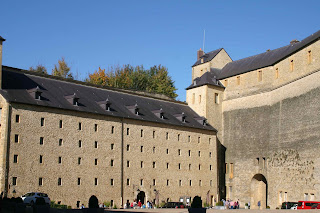It's easy to think of countries as self-evident units. After all, England was a country in the Middle Ages, with its borders pretty much the same as they are now (well, that's cheating, most of its borders are ocean). France was a country, and although big parts of what's now Belgium were part of France in the Middle Ages, and the medieval kingdom didn't include much along its eastern edge that's now firmly part of France (Alsace, the Jura region, Provence), most of what's France now was France then.
But a lot of borders and even countries are due to dynastic events in the Middle Ages (or early modern period). For example, we think of Spain as a country, with a little western bit being Portugal, but if Ferdinand of Aragon and Isabelle of Castile had not married in the fifteenth century (and for that matter driven the Muslims out of Grenada), the Iberian peninsula might have a lot more countries on it than it does now.
Even the division between France and Germany is due to family dynamics. Charlemagne's grandsons, Lothar, Louis, and Charles, decided to divide up what had been a single Frankish territory, rather than continuing to slug it out as to who got to be the heir. Lothar got to call himself emperor and got a slice down the middle of Frankish territory, including what are now parts of Belgium, Alsace and Lorraine, much of Switzerland, Provence, and a claim to Italy, including Rome, where emperors had to be crowned (the Italians had different ideas, but that's another story). This lasted for a little while, long enough for the name "Lothar's land" (Lotharingia) to become attached to, and give its name to, Lorraine (Alsace had long had its own name).
Louis and Charles went along with this division at the 843 Treaty of Verdun, but before too long they decided it was Not Fair for Lothar and his son Lothar II to hog both Aachen (Charlemagne's capital) and Rome, to say nothing of the imperial title. So they ganged up on him and divided Frankish territory between just the two of them, more or less along the Rhône-Saône river system, meaning Provence stayed under the German kings, even though it was culturally more French than anything, and even though Alsace and Lorraine continued to be a major source of contention for the next thousand years, as the Rhine (east side of Alsace) seemed more like a natural boundary than the line drawn on the map.
Then there are the countries that never quite made it, due to dynasties dying out. An excellent example is Sedan, in northern France, in the Ardennes near the Belgian border, more or less where the Champagne and Lorraine regions meet. You probably never heard of it, but in slightly different circumstances it could have been a much bigger and more powerful principality than Monaco or even Luxembourg.
Sedan is now noted for its castle, described as the biggest in Europe by the local tourist bureau, which may indeed be true (though Stirling in Scotland is also extremely large, as are some other royal castles). Sedan's castle is certainly enormous. It was begun in the late Middle Ages and added to and modified right up to the nineteenth century. This model will give you an idea of its size.
The interior courtyard will also give you some idea of the scale of the place. The multistory building was intended both as a garrison for troops and as a place to store weapons and munitions. It is now a luxury hotel.
It is not only huge but built with enormously thick walls. Succeeding generations of lords kept making them thicker and thicker. Cannon balls didn't stand a chance.
For a while the powerful lords of Sedan flourished. In the sixteenth century they converted to Protestantism and established a college for Protestants. The town had a profitable textile industry and book publishing industry. But then, in the seventeenth century, they ran out of heirs, and the principality was eventually absorbed into the French kingdom. If the family dynamic had been slightly different, they might have become their own country in the early nineteenth century, when western Europe's boundaries were (sort of) settled in the aftermath of the Napoleonic wars.
But Sedan was now firmly part of France. The French appreciated those heavy walls. But even medieval walls, maintained and added to over the generations, cannot by themselves win all battles, even though the castle was never actually taken. In the battle of Sedan in 1870, during the Franco-Prussian war, the outnumbered French army was in the city streets, being fired on from the surrounding hills by the superior German forces. The castle never fell, but emperor Napoleon III surrendered, rather than see all his troops slaughtered.
Sedan is worth visiting. Spend the day. There's a lot to see, and not many tourists.
An interesting book about how medieval dynasties shaped their countries' histories is by Robert Bartlett, Blood Royal (Cambridge University Press, 2020). (He talks about Charlemagne's grandsons, and a great many other royal dynasties, but not Sedan's lords, because they never actually called themselves royal.)
© C. Dale Brittain 2022
For more on medieval castles and nations, see my new ebook, Positively Medieval: Life and Society in the Middle Ages. Also available in paperback.




No comments:
Post a Comment